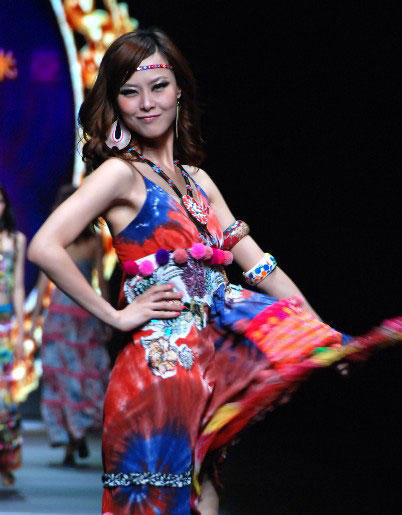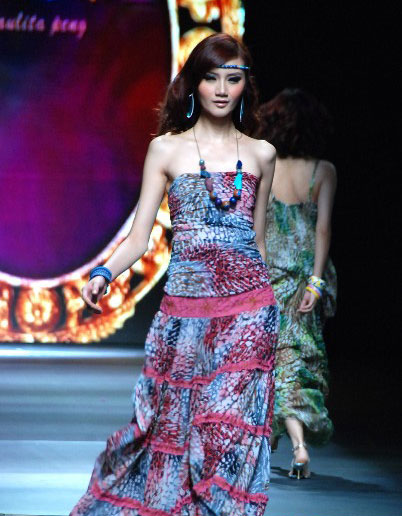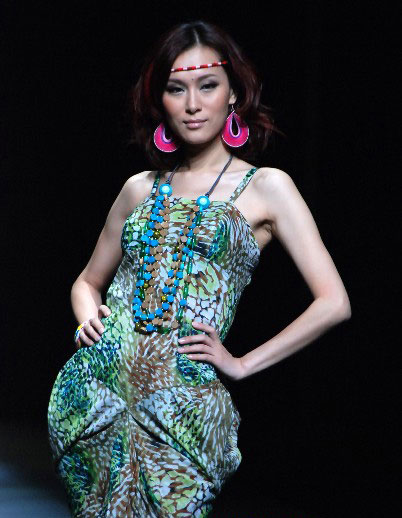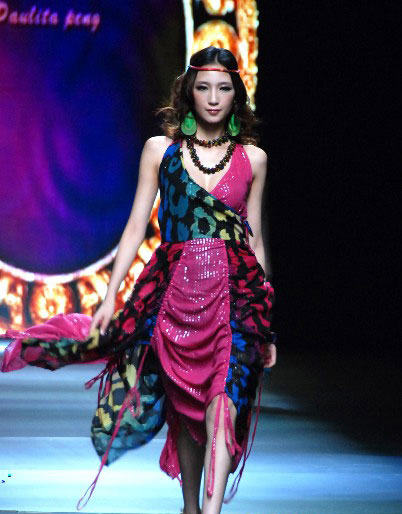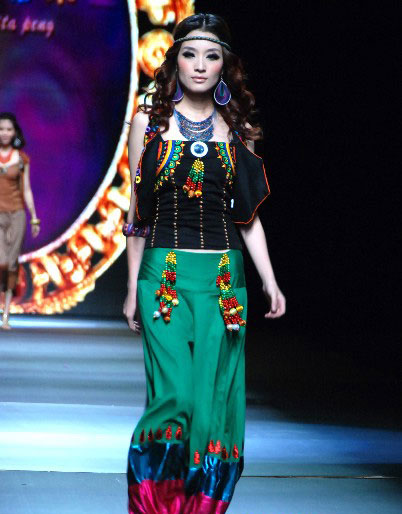 IVANA J
IVANA J Tini Tani
Tini Tani Millie V R
Millie V R Ala Konturek
Ala Konturek Hannnah P
Hannnah P
Models present creations from the Celia Vela Spring/Summer 2011 collection at the 080 Barcelona Fashion show July 15, 2010.
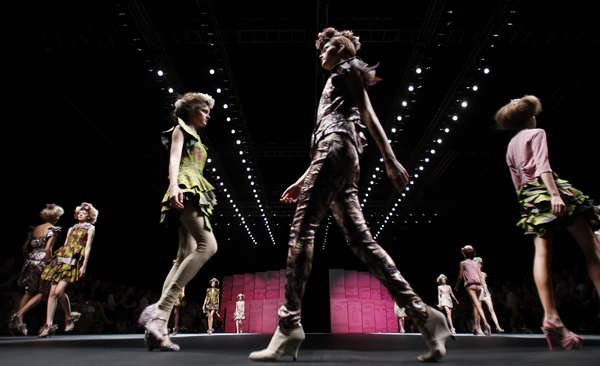
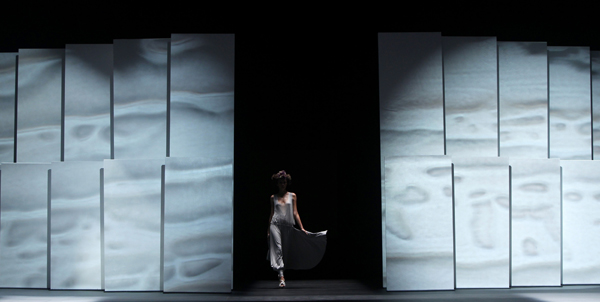
Models present creations from the Krizia Robustella spring/summer 2011 collection at the 080 Barcelona Fashion show July 14, 2010.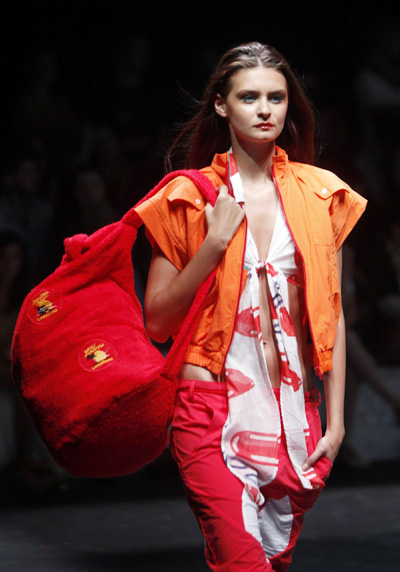
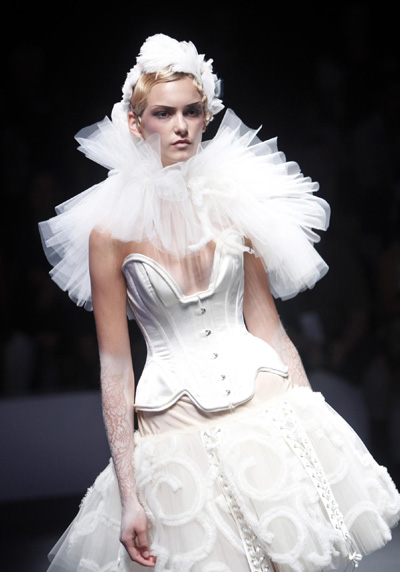
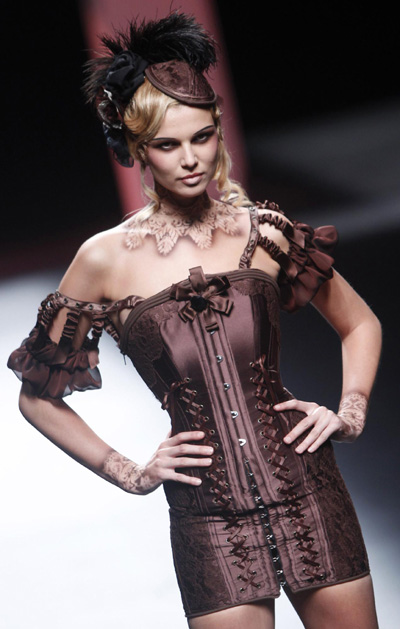
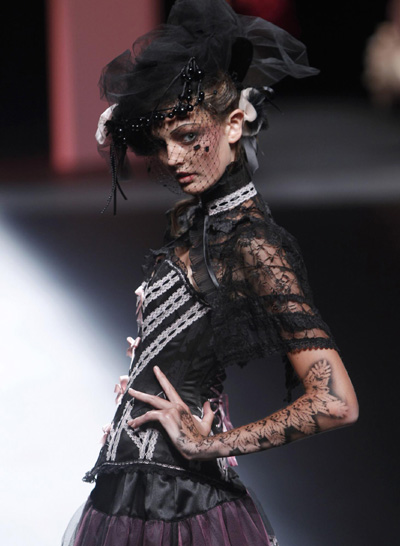
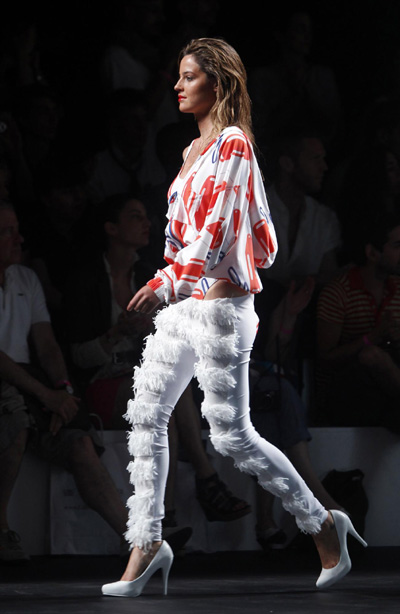
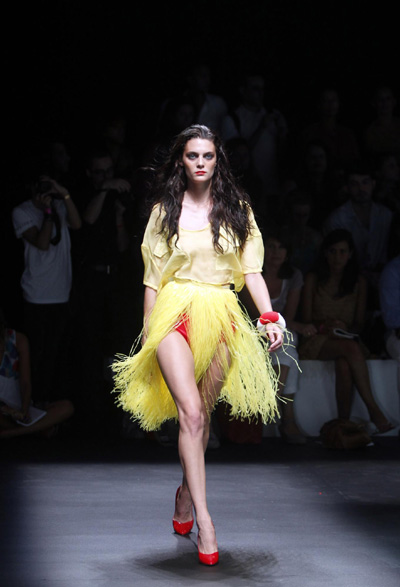
According to a latest report from McKinsey, Japan's luxury market is getting better.
McKinsey dose survey on common consumers and professionals respectively. It finally concludes that Japanese consumers become more cautious when they decide whether to buy luxury products or not. What's more, price becomes a more important factor than ever. However, it is sure that Japan's luxury market is on its way of recovery.
Although Japan's luxury market won’t surge, consumers' confidence improve significantly. 80% of 15 senior officials of luxury brands surveyed say that performances of their companies in 2010 are better than that in 2009. 33% of them predict that their sales will increase over 10%.
In 2009, 21% Japanese consumers thought that affordable common products could well meet their requirements, so there was no need to buy luxury products. In 2010, this rate decreases to 12%. All these statistics show that Japanese consumers' confidence improves.
Judging by the number of bared ankles appearing on the streets this summer, the rolled cuff look of 2009 appears to have become the rolled cuff epidemic of 2010. Legions of young men, including ones who are not bicycle messengers, are rolling up their pants legs to such high-water lengths that one is tempted to inquire where exactly the auditions for the Huckleberry Finn revival are being held. A style born on the shores of the Mississippi has been reinvented for the streets of Bushwick.
"It’s almost like a masculine shabby chic,” said Tom Julian, a fashion consultant and the author of two men’s style books with Nordstrom.
Every five years or so, the fashionable male discovers some styling trick to make the same old thing wearable in a dandy new way — the deep jeans cuff, the double-flipped shirt-sleeve cuff — and the next thing you know, men are trying it in Midtown.
The newest look, a lightly pinched cuff that should fall about an inch or two above the ankle, is likely a result of two factors. First, the skin-baring shrunken-suit style popularized by Thom Browne has, by now, become as acceptable to the mainstream as flat-front khakis. And second, the glorified boat shoes and retro canvas sneakers on the market seem to cry out to be worn with pants that will show them off. (A third, less likely factor might be the heat.)
"As cropped pants have become such a style, this is an easy way to get around shortening your pants by three inches,” said Josh Peskowitz, the style editor of Esquire.com, who had rolled up his pants that very morning. “It’s noncommittal.”
Getting the roll right is harder than it looks, and the experts differ on technique. Mr. Julian suggests rolling one inch of cuff three times for cotton canvas trousers, and a single two-inch cuff for dark jeans.
For slightly looser pants, like chinos, Mr. Peskowitz advises creating a peg by pinching the fabric slightly at the front during the rolling process. Starting from the bottom, you flip once, making as small a fold as possible, then twist the front of the pants leg by about an inch, then roll twice more while holding the pinch tightly. The pleats should stay in place.
"You want to make sure that both are pointing inward — for the left side, fold it to the right. For the right, fold it to the left — to stay symmetrical,” he said. “I just figured that out a couple of weeks ago.”
By the way, there are several don’ts. No formal shoes. No rolled-up skinny jeans. No wool pants — the rolls won’t stay. No bootleg pants, which should be burned anyway. And since rolled pants are meant to look casual, nothing about the outfit should be dressy, at the risk of looking too studied. While you’re at it, stop trying so hard.
Jim Moore, the creative director of GQ, said the goal should be to look nonchalant, since you don’t want to make the roll so perfect that it draws attention. “The roll has to feel a bit unintentional,” he said.
Given the unlikelihood of accidentally rolling up one’s pants, Mr. Moore offered some clarification: “You have to channel Johnny Depp for that moment and ask yourself, ‘How would Johnny Depp roll up the bottom of his pants?’ ”
If you still can’t figure it out, you might ask Mr. Depp about shorts.
Levi Strauss & Co. announced financial results for the second quarter ended May 30, 2010, and filed its second-quarter 2010 results on Form 10-Q with the Securities and Exchange Commission.
Second-quarter net revenues increased 8 percent compared to last year due to the continued worldwide growth of the Levi’s brand. Net revenues benefited from business acquisitions made during 2009 and ongoing retail expansion, partially offset by revenue declines in the wholesale channel in certain markets. Excluding the effect of currency, net revenues improved 5 percent.
Operating income improved from $56 million to $69 million through the positive effect of currency translation during the quarter. Below operating income, the company recorded financing costs and the non-cash write-down of deferred tax assets in the second quarter of 2010, partially offset by foreign currency gains during the quarter as compared to losses in the prior year. As a result, the net loss attributable to the company was higher as compared to last year. Due to first-quarter results, net income attributable to the company for the first six months of the year is consistent with the same period last year.
The company maintained a strong liquidity position during the second quarter. At May 30, 2010, cash and cash equivalents were $353 million and $180 million was available under its revolving credit facility.
"We had another good quarter, which gives us solid revenue growth and operating income for the first six months of the year,” said John Anderson, president and chief executive officer. “We are seeing the benefit of our investments in the business over recent years. The Levi’s brand is performing well, and consumers are responding to our more innovative products.”
Second-Quarter 2010 Highlights
• Gross profit in the second quarter increased to $499 million compared with $415 million for the same period in 2009. The increase in gross profit was driven by higher gross margins and the effects of currency. Gross margin for the second quarter increased to 51 percent of revenues compared with 46 percent of revenues in the same quarter of 2009. The gross margin improvement reflected increased contribution from company-operated retail stores, which typically generate a higher gross margin than the wholesale business.
• Selling, general and administrative (SG&A) expenses for the second quarter increased to $430 million from $359 million in the same period of 2009. Higher SG&A was primarily due to additional selling expenses related to the expansion of the company-operated retail network, higher advertising and promotion expense as the company increased support for its Levi’s and Dockers brands, and higher administration expenses associated with pension and postretirement benefit plans.
• Operating income for the second quarter was $69 million compared with $56 million for the same period of 2009. The 23 percent increase primarily reflects the favorable impact of currency as the higher gross margins were offset by higher SG&A expenses.
• In May 2010, the company offered €300 million aggregate principal amount of 7.75% Senior Notes due 2018 and $525 million aggregate principal amount of 7.625% Senior Notes due 2020. Net proceeds were used to retire the outstanding 9.75% Senior Notes due 2015 and 8.625% Senior Notes due 2013. Additionally, the company repurchased ¥10.9 billion aggregate principal amount of 4.25% Yen-denominated Eurobonds due November 22, 2016, for total consideration of $100 million.
Regional Overview
• Higher net revenues in the Americas were primarily due to the contribution of the outlet stores acquired in 2009 and strong Levi’s brand performance in men’s, juniors’ and boys’ products in the wholesale channel. These improvements were partially offset by lower Signature and U.S. Dockers brand sales.
• Net revenues in Europe benefited from the impact of the acquisition of the footwear and accessories business during 2009 and expansion of the company-operated retail network across the region. Revenue gains were partially offset by lower sales in the wholesale channel, reflecting the continued difficult retail environment across the region.
• Net revenues in Asia Pacific increased on a reported basis and decreased on a constant currency basis. Growth in the company’s developing markets in the region – driven by brand-dedicated retail store expansion – was more than offset by lower revenue performance in Japan.
The company ended the second quarter with cash and cash equivalents of $353 million, an increase of $82 million from November 29, 2009. Cash provided by operating activities was $146 million, compared with $159 million for the same period in 2009. Net debt was $1.46 billion at the end of the quarter, down from $1.58 billion at the end of 2009.
"We delivered solid operating results in the second quarter of 2010,” said Blake Jorgensen, chief financial officer. “Our cash flow is strong and we continued to build our liquidity position during the quarter. We also successfully completed the refinancing of our 2013 and 2015 debt maturities, as well as a portion of our 2016 Yen Eurobonds, extending our debt maturities and enabling us to focus on driving our growth strategies. As we continue to invest in the business, we remain focused on controlling costs and managing inventories.”
 O'Neill, the original California surf, snow and youth lifestyle brand, announced international supermodel Elyse Taylor as its brand ambassador to be featured in the marketing and consumer advertising efforts for O'Neill Girls through 2011. As part of the collaboration, O'Neill Girls will also be unveiling an exclusive swimwear collection, Elyse Taylor for O'Neill, later next year.
O'Neill, the original California surf, snow and youth lifestyle brand, announced international supermodel Elyse Taylor as its brand ambassador to be featured in the marketing and consumer advertising efforts for O'Neill Girls through 2011. As part of the collaboration, O'Neill Girls will also be unveiling an exclusive swimwear collection, Elyse Taylor for O'Neill, later next year.
Born in Vaucluse, Sydney, Taylor is one of today's most coveted young models. Since her career began, the Australian beauty has worked with high fashion brands including Victoria's Secret, and appeared on runways for Marc Jacobs, Alberta Ferretti, Dolce & Gabbana, and Roberto Cavalli. For O'Neill Girls, she will be included in retail and online videos, digital and print advertising, product hangtags, and other promotional content. Imagery from O'Neill's Spring 2011 photo shoot, shot on location in the Virgin Islands by Kyle Alexander, will debut at the Miami Swim Tradeshow this weekend.
"We are thrilled to be partnering with someone as talented, creative and down to earth as Elyse," said Cedar Carter, Marketing Director for O'Neill Girls. "She's a laid back beach girl who also has a lot of energy and style. She not only embodies the O'Neill Girls lifestyle, but also loves fashion and design, and has walked the runways for many of our girls' favorite brands. She is a wonderful addition to our team."
"I've always been a huge fan of O'Neill and am excited to be working with the company on various projects for 2011," added Taylor. "Growing up along the coast, the water and the beach were always part of my life, so it's great to work with a brand that represents so many of my passions. I'm really looking forward to collaborating with the design teams, drawing inspiration from O'Neill's California roots and my own experiences travelling around the world."
Scheduled for release in 2011 at specialty retailers and boutiques, Elyse Taylor for O'Neill will complement the brand's 2011 lifestyle collections that merge 1970's retro surf styling with indie culture and ethnic influences.
O'Neill Girls is dedicated to and inspired by the adventurous and free-spirited young female. Driven by O'Neill's heritage as the original California surf brand since 1952, O'Neill Girls stays true to its roots, while offering a unique fashion perspective that is modern and fresh. Featuring a range of styles for all seasons both on and off the beach, O'Neill Girls includes a blend of effortlessly cool prints, dresses, tees, denim, fleece, jackets, accessories, swimwear and wetsuits.
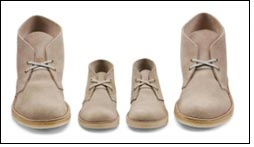 On the heels of the 60th anniversary of the Desert Boot in 2009, Clarks announces the rebirth of two iconic styles, now as children’s footwear. For the first time in North America, Clarks Originals Desert Boot and Clarks Originals Wallabee Boot will be available for children; from little ones taking their first steps to stylish kids heading off to school. The Clarks Originals kids collection will join the ranks of the cult classic Desert Boot and popular Wallabee Boot for adults that have been wardrobe staples for a generation of trendsetters.
On the heels of the 60th anniversary of the Desert Boot in 2009, Clarks announces the rebirth of two iconic styles, now as children’s footwear. For the first time in North America, Clarks Originals Desert Boot and Clarks Originals Wallabee Boot will be available for children; from little ones taking their first steps to stylish kids heading off to school. The Clarks Originals kids collection will join the ranks of the cult classic Desert Boot and popular Wallabee Boot for adults that have been wardrobe staples for a generation of trendsetters.
Staying true to the heritage of the brand, Clarks Originals for Little Individuals are crafted with the same plush suedes and authentic leathers as their adult counterparts. But with an eye on the end consumer, special care has been taken to provide little individuals with the perfect fit. The use of a non-crepe rubber sole allows for a safer walking experience and a slightly wider last grants more room for tiny growing toes.
The collection is comprised of three categories: First, for first-walkers sizes 5.5 to 8; Toddler, for sizes 8.5 to 13; and Junior, for youth sizes 13.5 to 3. The Desert Boot is available in iconic sand suede, chestnut leather, black suede, and for the first time ever, plum suede and pink suede. The Wallabee Boot is available in sand suede and beeswax leather. With the addition of these two classic looks for kids, these styles will now be available from first-walkers to the top of the adult size range in a variety of colors and materials.
Clarks Originals for kids will be available exclusively at the following Clarks Retail stores across the country beginning in July. Following their July debut in these locations, other fine retailers and better independents will carry select styles from the collection as well.
 The U.S. cotton crop for 2010 was revised upward this month and is now projected at 18.3 million bales, 10 percent above the June projection and 50 percent above the two-decade-low 2009 crop. An increase in planted area estimated in the June Acreage report (see table 11) provided half of this month’s adjustment. The other half of the increase was attributable to the favorable crop conditions to date in the Southwest region. As a result, a lower abandonment and higher yield are forecast in July as compared with June.
The U.S. cotton crop for 2010 was revised upward this month and is now projected at 18.3 million bales, 10 percent above the June projection and 50 percent above the two-decade-low 2009 crop. An increase in planted area estimated in the June Acreage report (see table 11) provided half of this month’s adjustment. The other half of the increase was attributable to the favorable crop conditions to date in the Southwest region. As a result, a lower abandonment and higher yield are forecast in July as compared with June.
Based on the June Acreage report, U.S. producers indicated that they had planted or intended to plant 10.9 million acres to cotton in 2010, about 4 percent above the March Prospective Plantings report and the highest in 4 years. While planted area is estimated 19 percent above 2009, harvested area is projected 38 percent higher as beneficial crop conditions are expected to reduce abandonment. Nationally, U.S. abandonment for 2010 is projected at about 5 percent, less than half the historical average. Consequently, 2010 abandonment is forecast at about 0.5 million acres, compared with last season’s 1.6 million acres or 18-percent rate.
Upland cotton area increased across each region of the Cotton Belt for 2010, ranging from 13 percent to 40 percent higher than last season. The Southwest region rose more than 700,000 acres in 2010 to about 6 million. Perhaps even more important than higher planted area is the likelihood that low abandonment will raise Southwest harvested area by 50 percent from 2009. The Southeast is estimated to have planted 2.5 million acres, or more than 600,000 acres higher than in 2009. The Delta has planted about 1.9 million acres, compared with a historical low of only 1.6 million acres in 2009.
Meanwhile, upland area in the West is forecast to rise after 5 consecutive years of decline. In 2010, the region has planted an estimated 345,000 acres, nearly 100,000 acres above 2009. In addition, extra-long staple plantings most of which are in the West are projected at 209,000 acres, nearly 50 percent more than a year ago and the highest ELS area in 3 seasons.
As of early July, the 2010 U.S. cotton crop is progressing near its average while conditions are much improved. Overall, 56 percent of cotton area was squaring as of July 4th, compared with the 5-year average of 55 percent. Area setting bolls this year was reported at 13 percent, compared with an average of 15 percent.
Meanwhile, U.S. cotton crop conditions are well above both last season and the 5- year average. As of July 4th, 65 percent of the U.S. area was rated “good” or “excellent,” compared with only 42 percent last season. As mentioned earlier, conditions in the Southwest are favorable this season and, as of early July, crop conditions in the Southwest are at their best since 1994. These conditions support the lower U.S. abandonment and higher yield forecast in July.
As of early July, the 2010 U.S. cotton crop is progressing near its average while conditions are much improved. Overall, 56 percent of cotton area was squaring as of July 4th, compared with the 5-year average of 55 percent. Area setting bolls this year was reported at 13 percent, compared with an average of 15 percent. Meanwhile, U.S. cotton crop conditions are well above both last season and the 5- year average. As of July 4th, 65 percent of the U.S. area was rated “good” or “excellent,” compared with only 42 percent last season. As mentioned earlier, conditions in the Southwest are favorable this season and, as of early July, crop conditions in the Southwest are at their best since 1994. These conditions support the lower U.S. abandonment and higher yield forecast in July.
Cotton Demand and Stocks Revised for 2010/11; Unchanged for 2009/10 As the beginning of 2010/11 approaches, projections of demand for the upcoming season were increased along with the sizable gain expected in supply. In July, total U.S. cotton demand was forecast at 17.7 million bales, nearly 2 million bales above the 2009/10 estimate. While U.S. mill use was increased 100,000 bales (3 percent) this month to 3.4 million bales—the same as in 2009/10 exports were raised 800,000 bales (6 percent) to 14.3 million—2 million bales above 2009/10.
Strong foreign demand and continued tight world supplies are projected to boost the U.S. share of world trade. With the United States accounting for about half of the 2010/11 increase in global production, the U.S. share of world trade is expected to rise to nearly 39 percent, slightly above the 2007-09 average. Similarly, the U.S. share of global consumption is expected to rise slightly in 2010/11. As 2009/10 draws to a close, U.S. cotton disappearance (exports plus mill use) is accounting for approximately 13.5 percent of world consumption, the lowest in over 2 decades. In 2010/11, however, the projection for increased U.S. demand is expected to push this share to about 15 percent, similar to the 2006-2008 seasons.
Based on the latest supply and demand estimates, 2010/11 stocks are expected to rise from 2.9 million bales when the season starts on August 1, 2010, to 3.5 million bales at season’s end. Just as actual stocks are projected to rise slightly in 2010/11, the stocks-to-use ratio is also forecast to increase from 18.5 percent in 2009/10 to nearly 20 percent in 2010/11. Meanwhile, farm prices for 2010/11 are likely to exceed the 2009/10 estimate. Upland prices are projected to range between 60 and 74 cents per pound in 2010/11, compared with a 62.5-cent average estimated for 2009/10.
Models display creations as part of Lebanese designer Abed Mahfouz's collection during Fashion Week in Rome July 13, 2010.
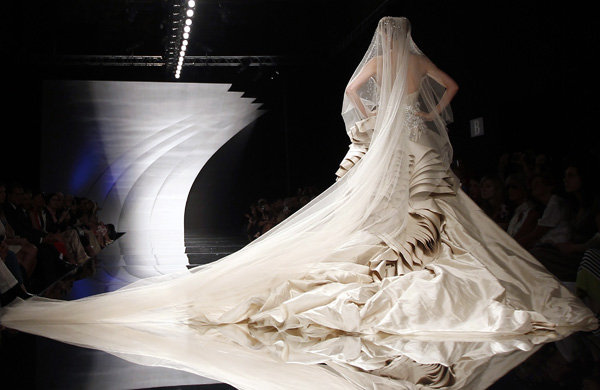

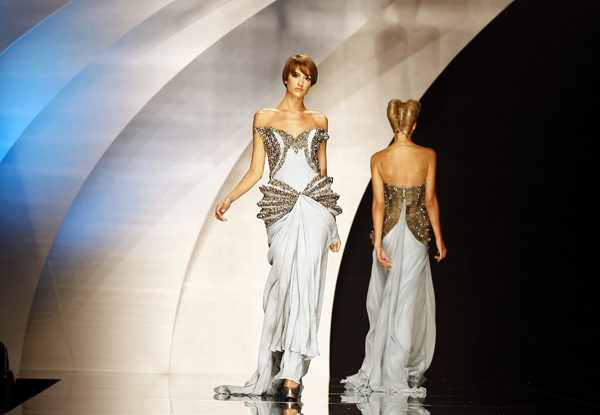
Models present creations of Polita Peng during Shenzhen International Apparel Fair in No.5 Hall of Shenzhen Convention & Exhibition Center on 9th, July. A large number of fashionists attended this show.
Bohemian style used to belong to optimistic gypsy. They are fond of freedom and wandering.
Bohemian style is featured with color collision and various flowery prints.
